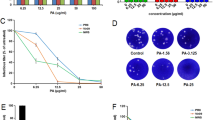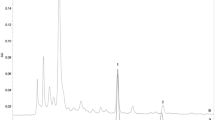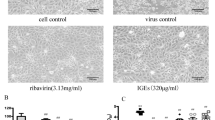Abstract
Influenza viruses can bring about acute respiratory diseases and are a potential hazard to human health. Antiviral drugs are the main ways to control the influenza virus infection except the vaccine. In this study, the immune regulation activity of pterodontic acid isolated from Laggera pterodonta induced by influenza A virus in vitro was evaluated. In studies on anti-influenza activity, our results showed that it maybe target the influenza protein of polymerase basic 1 (PB1), polymerase basic 2 (PB2), polymerase acid (PA), nuclear protein (NP), non-structural protein (NS), and matrix protein (M) but not hemagglutinin (HA) and neuraminidase (NA). In studies on immune regulation, our results demonstrated that pterodontic acid can inhibit the Retinoic acid inducible gene-I (RIG-I) expression in mRNA and protein level at 100 μg/ml, then further to clarify its action on the signalling pathway, The results indicated that pterodontic acid can inhibit the Tumor Necrosis Factor-related Apoptosis-inducing Ligand/Fas Ligand (TRAIL/Fasl) expression in mRNA level at 100 μg/ml; the cleaved caspase 3/7, p-NF-KB, and p-ERK were all suppressed in protein level by pterodontic acid at 100 μg/ml. This confirmed its mechanism that restrained the nuclear export of viral RNPs. The interferon system was also affected, the STAT1, IFN-α, IFN-β expression were also inhibited by pterodontic acid at 25–100 μg/ml and also, the important programmed death-ligand of PD-L1 and PD-L2 was inhibited at 50–100 μg/ml. The mechanisms of pterodontic acid against influenza virus infection may be a cascade inhibition and it has the anti-inflammatory activity, which has no side effect, and can be as a supplement drug in clinical influenza virus infection.





Similar content being viewed by others
References
Carty M, Bowie AG (2010) Recent insights into the role of Toll-like receptors in viral infection. Clin Exp Immunol 161:397–406
Chen H, Jie C, Tang LP, Meng H, Li XB, Li YB, Chen LX, Yan C, Kurihara H, Li YF (2017) New insights into the effects and mechanism of a classic traditional Chinese medicinal formula on influenza prevention. Phytomedicine 27:52–62
Ding Y, Zeng L, Li R, Chen Q, Zhou B, Chen Q, Cheng PL, Wang Y, Zheng J, Yang Z (2017) The Chinese prescription lianhuaqingwen capsule exerts anti-influenza activity through the inhibition of viral propagation and impacts immune function. BMC Complement Altern Med 17:130
Flowers S, PhD DPT, Molas-Gallart J, Davies DA (2014) A polymethoxyflavone from Laggera pterodonta induces apoptosis in imatinib-resistant K562R cells via activation of the intrinsic apoptosis pathway. Cancer Cell Int 14:1–8
Gu JL, Li ZJ, Zhang HX, Du ZZ (2015) Fragrant volatile sesquiterpenoids isolated from the essential oil of Laggera pterodonta by using olfactory-guided fractionation. Chem Biodivers 11:1398–1405
Guan W, Li J, Chen Q, Jiang Z, Zhang R, Wang X, Yang Z, Pan X (2017) Pterodontic acid isolated from Laggera pterodonta inhibits viral replication and inflammation induced by influenza a virus. Molecules 22:1738
Hadi M, Singh AK, Speak AO, Vincent L, Jonathan L, Bryant K, Kyung Soo I, Sharpe AH, Jung JU, Omid A (2013) Lack of PD-L1 expression by iNKT cells improves the course of influenza A infection. PloS One 8:e59599
Hussain M, Galvin HD, Haw TY, Nutsford AN, Husain M (2017) Drug resistance in influenza A virus: the epidemiology and management. Infect Drug Resist 10:121
La-Gruta N, Kedzierska K, Doherty JP (2007) A question of self-preservation: immunopathology in influenza virus infection. Immunol Cell Biol 85:85–92
Lee CW (2014) Reverse genetics of influenza virus: animal influenza virus. Springer, New York, pp 143–154
Livak KJ, Schmittgen TD (2001) Analysis of relative gene expression data using real-time quantitative PCR and the 2(-Delta Delta C(T)) method. Methods (San Diego Calif) 25:402–408
Marjolaine V, Elisabeth K, Michael E, Nicolas RR (2011) The airway epithelium: soldier in the fight against respiratory viruses. Clin Microbiol Rev 24:210–229
Meraz MA, White JM, Sheehan KC, Bach EA, Rodig SJ, Dighe AS, Kaplan DH, Riley JK, Greenlund AC, Campbell D (1996) Targeted disruption of the Stat1 gene in mice reveals unexpected physiologic specificity in the JAK-STAT signaling pathway. Cell 84:431–442
Nimmerjahn F, Dudziak DU, Hobom G, Riedel A, Schlee M, Staudt LM, Rosenwald A, Behrends U, Bornkamm GW, Mautner J (2004) Active NF-kappaB signalling is a prerequisite for influenza virus infection. J Gen Virol 85:2347–2356
Noshi T, Kitano M, Taniguchi K, Yamamoto A, Omoto S, Baba K, Hashimoto T, Ishida K, Kushima Y, Hattori K et al (2018) In vitro characterization of baloxavir acid, a first-in-class cap-dependent endonuclease inhibitor of the influenza virus polymerase PA subunit. Antiviral Res 160:109–117
Paules C, Subbarao K (2017) Influenza. Lancet (Lond Engl) 390:697–708
Pleschka S, Wolff T, Ehrhardt C, Hobom G, Planz O, Rapp UR, Ludwig S (2001) Influenza virus propagation is impaired by inhibition of the Raf/MEK/ERK signalling cascade. Nat Cell Biol 3:301–305
Shang X, Liabsuetrakul T, Sangsupawanich P, Xia X, He P, Cao H, Mcneil E (2017) Efficacy and safety of Laggera pterodonta in children 3–24 months with acute bronchiolitis: a randomized controlled trial. Clin Respir J 11:296
Shi S, Huang K, Zhang Y, Zhao Y, Du Q (2007) Purification and identification of antiviral components from Laggera pterodonta by high-speed counter-current chromatography. J Chromatogr B 859:119–124
Wang X, Liu Z (2014) Prevention and treatment of viral respiratory infections by traditional Chinese herbs. Chin Med J 127:1344
Wang X, Jia W, Zhao A, Wang X (2010) Anti-influenza agents from plants and traditional Chinese medicine. Phytother Res 20:335–341
Wang YT, Zhou B, Lu J, Chen QL, Ti H, Huang WY, Jing L, Yang ZF, Jiang Z, Wang XH (2017) Inhibition of influenza virus via a sesquiterpene fraction isolated from Laggera pterodonta by targeting the NF-κB and p38 pathways. BMC Complement Altern Med 17:25
Wang Y, Li J, Yan W, Chen Q, Jiang Z, Zhang R, Pan X, Wang X (2018) An active component containing pterodontic acid and pterodondiol isolated from Laggera pterodonta inhibits influenza A virus infection through the TLR7/MyD88/TRAF6/NF-κB signaling pathway. Mol Med Rep 18:523–531
Webster RG, Bean WJ, Gorman OT, Chambers TM, Kawaoka Y (1992) Evolution and ecology of influenza A viruses. Curr Top Microbiol Immunol 56:359–375
Wu Y, Zhou C, Li X, Song L, Wu X, Lin W, Chen H, Bai H, Zhao J, Zhang R (2010) Evaluation of antiinflammatory activity of the total flavonoids of Laggera pterodonta on acute and chronic inflammation models. Phytother Res 20:585–590
Wurzer WJ, Ehrhardt C, Pleschka S, Berberich-Siebelt F, Wolff T, Walczak H, Planz O, Ludwig S (2004) NF-kappaB-dependent induction of tumor necrosis factor-related apoptosis-inducing ligand (TRAIL) and Fas/FasL is crucial for efficient influenza virus propagation. J Biol Chem 279:30931–30937
Yang L, Zhu W, Li X, Chen M, Wu J, Yu P, Qi S, Huang Y, Shi W, Dong J (2017) Genesis and spread of newly emerged highly pathogenic H7N9 Avian Viruses in Mainland China. J Virol. 91:JVI.01277-01217
Ym L, Jr GM (2011) Immune signaling by RIG-I-like receptors. Immunity 34:680–692
Acknowledgements
This work was supported by the National Natural Science Foundation of China (Grant no. U1502226), the Engineering Technology Research Center (Development) of Guangdong general universities (Grant no. GCZX-A1408), and Youth Innovative Talents project of Department of Education of Guangdong Province (Grant no. 2017KQNCX169).
Author information
Authors and Affiliations
Corresponding authors
Ethics declarations
Conflict of interest
The authors declare that they have no conflict of interest.
Additional information
Publisher's Note
Springer Nature remains neutral with regard to jurisdictional claims in published maps and institutional affiliations.
Rights and permissions
About this article
Cite this article
Wang, Y., Zeng, Z., Chen, Q. et al. Pterodontic acid isolated from Laggera pterodonta suppressed RIG-I/NF-KB/STAT1/Type I interferon and programmed death-ligand 1/2 activation induced by influenza A virus in vitro. Inflammopharmacol 27, 1255–1263 (2019). https://doi.org/10.1007/s10787-019-00571-y
Received:
Accepted:
Published:
Issue Date:
DOI: https://doi.org/10.1007/s10787-019-00571-y




